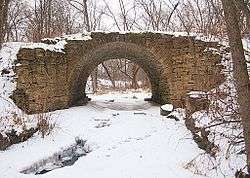Point Douglas–St. Louis River Road Bridge
The Point Douglas–St. Louis River Road Bridge is the oldest known stone arch bridge in the state of Minnesota. The current bridge was built in 1865.[2] It was constructed in Stillwater Township to carry the Point Douglas to Superior Military Road over Brown's Creek. The bridge was listed on the National Register of Historic Places in 1975 for having local significance in the themes of engineering and transportation.[3] It was nominated as an example of stone engineering and as a remnant of Minnesota's early government roads.[4]
Point Douglas-St. Louis River Road Bridge | |
 The Point Douglas–St. Louis River Road Bridge viewed from the east | |
  | |
| Location | Off County Highway 5, Stillwater Township, Minnesota |
|---|---|
| Coordinates | 45°4′32″N 92°49′44″W |
| Area | 0.5 acres (0.20 ha) |
| Built | 1865 |
| Architect | William Willim |
| MPS | Washington County MRA (AD) |
| NRHP reference No. | 75001033[1] |
| Designated | February 24, 1975 |
History
The road that was carried by the bridge was built as one of Minnesota's earliest road construction projects. When Minnesota became a territory in 1849, there were few land transportation routes other than the Red River Trails, although water transportation was possible along the rivers. Henry Hastings Sibley, who later became Minnesota's first governor, appealed to the United States Congress in 1850 for funds to build a network of military roads in Minnesota Territory.[5] The Minnesota Road Act was passed in July 1850. The Point Douglas to Superior Military Road was authorized from Point Douglas (north of present-day Hastings), through Cottage Grove, Stillwater, Marine Mills (now Marine on St. Croix), Falls of St. Croix (now Taylors Falls), and to the "Falls or Rapids of the Saint Louis River of Lake Superior".[6] The presumed purpose of these military roads was to provide a way for army troops to move quickly to an area where they were needed, but in practice these roads were more often used by civilians traveling between existing settlements or settling new areas.[5]
James H. Simpson, an officer in the U.S. Army and a member of the United States Corps of Topographical Engineers, was placed in charge of road construction. As specified in his construction bid, the original bridge built during the construction of the military road was wooden. Federal involvement in the road projects ended after Minnesota became a state, and the last personal left st. Paul in 1861. By 1863, it was clear a new, sturdier bridge was needed. On September 2, 1863, a contract was made with Michael Hanley and Fredrick Curtis for the construction of a stone bridge across Brown's Creek by the Washington County Commissioners. But, when Curtis and Hanley appeared before the County Commissioners to receive payment, on November 20, 1863, the commissioners stated that their contract was not fulfilled and their work was not accepted for unknown reasons. On August 3, 1865, a motion was made to have Commissioner William Willim lead and oversee the construction of a replacement bridge. Commissioner Willim's bridge was completed and accepted by the County on October 17, 1865 at a cost of $1197.38. Brown's Creek had been diverted south to power one of the first sawmills in Stillwater, and the remaining trickle was easy to ford.[4] The Point Douglas to St. Louis River Road was never fully completed as a military road because Congress only allocated $10,000, $15,000, or $20,000 at a time, so Sibley and other representatives had to keep appealing to Congress for more funds to complete the roads. By 1858, the year Minnesota became a state, two-thirds of the Point Douglas to St. Louis River Road was substantially complete.[5]
The bridge is built of locally quarried limestone by Washington County Commissioner William Willim, who also was a stone and plaster contractor. The stone bridge was used until about 1891, when a wider wood bridge was built about 200 feet (60 m) east of the stone bridge, and the road was shifted onto a new alignment. In 1905 a local miller incorporated the bridge into a three-story mill on the site. The mill did not succeed, and it was torn down in 1927, leaving only the bridge.[5]
See also
References
- "National Register Information System". National Register of Historic Places. National Park Service. July 9, 2010.
- Record June 4, 1860 to April 23, 1873. Washington County (Minn.) Board of County Commissioners Minutes and Agenda Packets. Minnesota Historical Society.
- "Point Douglas-Saint Louis River Road Bridge". Minnesota National Register Properties Database. Minnesota Historical Society. 2009. Retrieved 2015-06-19.
- Hackett, John J. (1974-09-30). "National Register of Historic Places Inventory – Nomination Form: Stone Bridge". National Park Service. Retrieved 2015-11-18. Cite journal requires
|journal=(help) - Gardner, Denis P. (2008). Wood, Concrete, Stone, and Steel: Minnesota's Historic Bridges. Minneapolis: University of Minnesota Press. pp. 31–34. ISBN 978-0-8166-4666-1.
- "Bills and Resolutions, House of Representatives, 31st Congress, 1st Session: H.R. 21". A Century of Lawmaking for a New Nation: U.S. Congressional Documents and Debates, 1774-1875. Library of Congress. February 4, 1850. Retrieved 2009-10-04.

